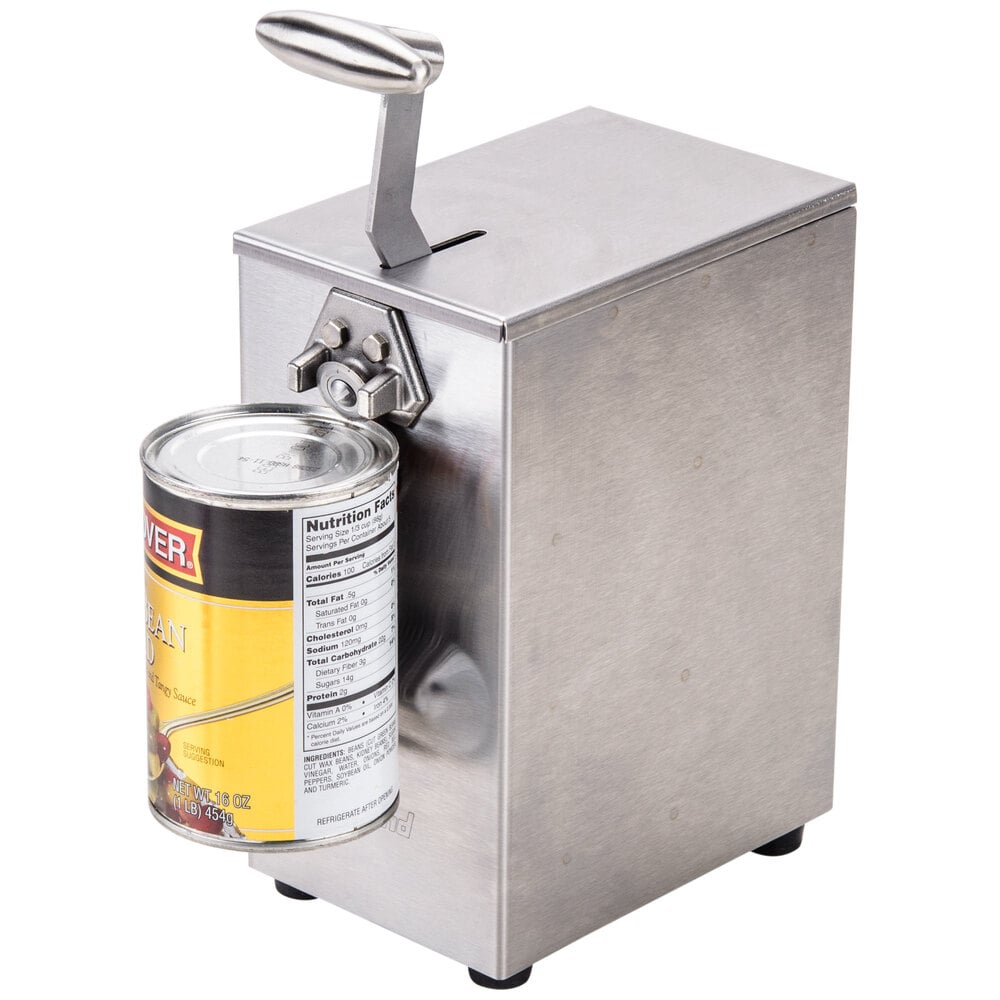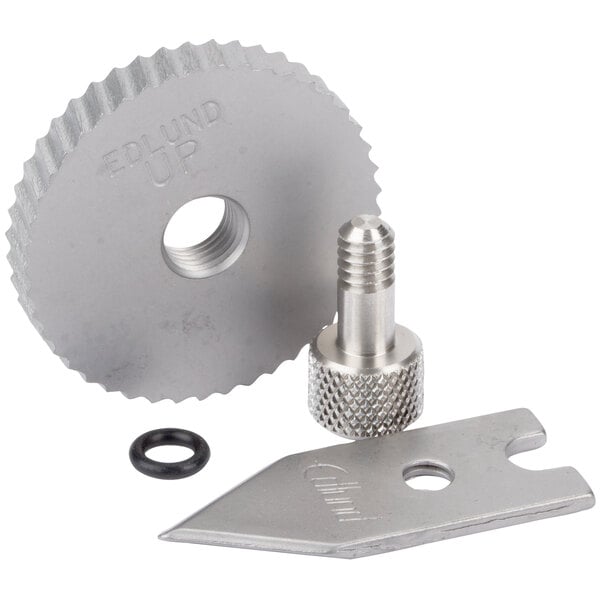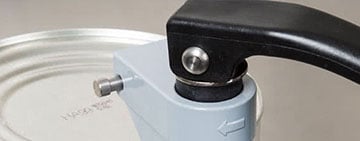
Can Openers Guide
Different Types of Can Openers
The handheld can opener is a trusty tool that many of us are familiar with from home use, from common crank handle can openers to even simpler lever type can openers used to pry a can open.
But in a commercial setting, the need to open more cans, and larger cans, usually necessitates a more robust product. Manual can openers provide a step up in terms of production. Electric can openers take some of the physical strain off of your employees in addition to offering better capacity. And crown punch can openers deliver the speed and simple operation needed when opening cans is a big part of your business.

Manual Can Openers
Manual can openers work by punching the lid with a blade and turning a crank handle, which rotates the can against the blade and cuts the top free. This design makes them a great basic choice for a #10 can opener, though they can handle many other can sizes common in commercial foodservice, too. There are three types of manual can openers, and generally as you progress from light, to standard, to heavy duty the number of cans that each unit can handle increases.
- Light-Duty: Occasional use
- Standard-Duty: 2-3 cans per minute, 15-25 cans per day
- Heavy-Duty: 4-6 cans per minute, up to 50 cans per day
Often the difference between standard and heavy duty can openers comes down to the size - A standard duty can opener is a bit smaller, with a shorter handle that may require more turns to open the same can. A heavy duty can opener is larger and features a more heavy-duty construction. When considering which one to buy, you'll also want to look at other design points, like whether it is NSF or UL listed, and whether it uses a screw-in base that's designed for permanent mounting, or a clamp base that can be moved around as needed. Some higher-end can openers also remove the threat of metal shavings and jagged edges by cutting the lid off along the side wall of the can instead of cutting out the top.

Electric Can Openers
Electric can openers operate with just the pull of a lever or press of a button; the gear mechanism pulls the can in tight while it spins under a dull blade, removing the top.
These units are designed to accommodate a variety of can sizes. Electric can openers are a favorite of K-12, colleges and universities, and healthcare applications due to their easy single hand operation. They are typically suitable for 75 to 200 cans per day, at 4-7 cans per minute, though light duty models are available. Many electric can openers are also UL and NSF Listed.

Crown Punch Can Openers
A crown punch can opener is ideal for heavy volume use where speed and durability are must-haves. A circular set of blades is inserted in to the lid of the can and the entire lid is cut free in one swift motion.
Crown punch can openers can easily open between 100 to 3000 cans per day, at 6 – 10 cans per minute. The blades on a crown punch can opener are normally set to open standard #10 food service cans, but other sizes can typically be configured as well.
Manual versions use a lever to push the blades down, but air-powered models are a desirable choice for the highest-volume applications, since they don't require an electrical connection and instead use pressurized air to force the blade down. You might also consider a unit with a magnetic lid remover to make it easier to move from one can to the next.
Can Opener Maintenance Tips
Using the right can opener for the job can help avoid constantly replacing parts, or the need for a new can opener. Here are some additional maintenance tips:
- Regular cleaning will prolong unit life.
- Inspect and change knives and gears regularly. Knives and gears should last for approximately 2,500 - 5,000 cans and should always be replaced at the same time.
- Manual can opener knives are reversible, to extend blade life.
- Edges are intentionally dull on knives and crown punch blades to prevent metal slivers, therefore they should not be sharpened.

Can Opener Replacement Parts
We carry a variety of replacement parts to keep your can opener working properly, no matter which type you have! Whether you need new knives and gears, a new base, or some more complex parts for an electric or crown punch model, we've got you covered.
Related Resources

Can Opener Reviews
Check out our can opener reviews to find the product that will complete your food prep area. These top can openers help you quickly and easily open cans of fruit, vegetables, filling, sauces, fish, and other cooking ingredients, so you can complete your signature dishes. Choose from hand-held and wall-mount units for light-duty applications, or purchase a table-mount option for more heavy-duty can opening. You can even find electric can openers that make opening cans even quicker. By using our can opener comparison to make your purchasing decision, you're sure to find the perfect product for your commercial kitchen.

Food Cans Buying Guide
Canned goods extend the shelf life of many food items without sacrificing nutritional value for a lower cost than fresh or frozen options . Unlike fresh produce that loses nutrients over time and frozen products that may lose nutrients through oxidation, canned foods are sealed at peak ripeness and retain their nutritional properties for extended periods. With advantages such as preserving food quality over time, extending product shelf life, and ensuring packaging safety, food cans play a crucial role in foodservice. Shop All Canned Vegetables

Restaurant Safety Tips
With sharp equipment, open flames, and tight spaces, there are many safety risks present in a restaurant. To keep your establishment safe for employees as well as customers, it's important to be aware of these hazards and minimize them as much as possible. Keep reading for our guidelines on how to train your employees, operate equipment, and prevent fires and common injuries to ensure that your restaurant operates safely for everyone. Shop All Safety and Security Products 1. Train Your Employees in Restaurant Safety Procedures To maintain a safe working environment, staff members must follow safety procedures. Your kitchen is only as safe as your employee who has received the least amount of training. For this reason, investing time i
- Topics 1346
- Industrial 55
- Troubleshooting Guides 21
- Restaurant Management 128
- Bar Management 55
- Catering Tips 35
- Bakery Management 42
- Food Trucks & Concessions 49
- Advertising & Marketing 37
- Eco-Friendly Tips 11
- Facility Layout & Design 41
- Coffee Shop Tips 28
- Installation & Maintenance 51
- Janitorial & Pest Control 30
- Safety & Sanitation 88
- Startup Tips 104
- Menu Design 10
- Kitchen & Cooking Tips 81
- Hospitality Management 23
- Pizza & Sandwich Shop Tips 36
- Smallwares 37
- Food Prep 88
- Tabletop Items 17
- Disposables 22
- Calculators & Tools 6
- Consumables 52
- Warewashing & Laundry 18
- Cooking Equipment 90
- Food Storage & Refrigeration 51
- Beverage Equipment 34
- Office Supplies 6
- Resource Type
- In-Depth Articles272
- Buying Guides296
- How-Tos93
- Product Reviews77


